Economics Assignment: Inflation, Deflation and Economic Impacts
VerifiedAdded on 2022/09/25
|16
|4009
|21
Homework Assignment
AI Summary
This economics assignment examines the impacts of inflation and deflation on an economy, using the Central Bank of Turkey's analysis of March 2020 as a case study. It defines inflation and distinguishes between CPI and Core CPI, referencing data from the provided article. The assignment includes a diagram illustrating the impact of selling vegetables on domestic market prices, along with explanations of how workers and export demand are affected by inflation. It also evaluates monetary policy options for controlling inflation, such as monetary and fiscal policies, supply-side policies, and wage controls. Additionally, the assignment touches upon the risks of deflation in Japan, discussing its potential economic consequences and the limited policy options available. The analysis covers various factors, including exchange rates, interest rates, and government intervention, providing a comprehensive overview of macroeconomic concepts.
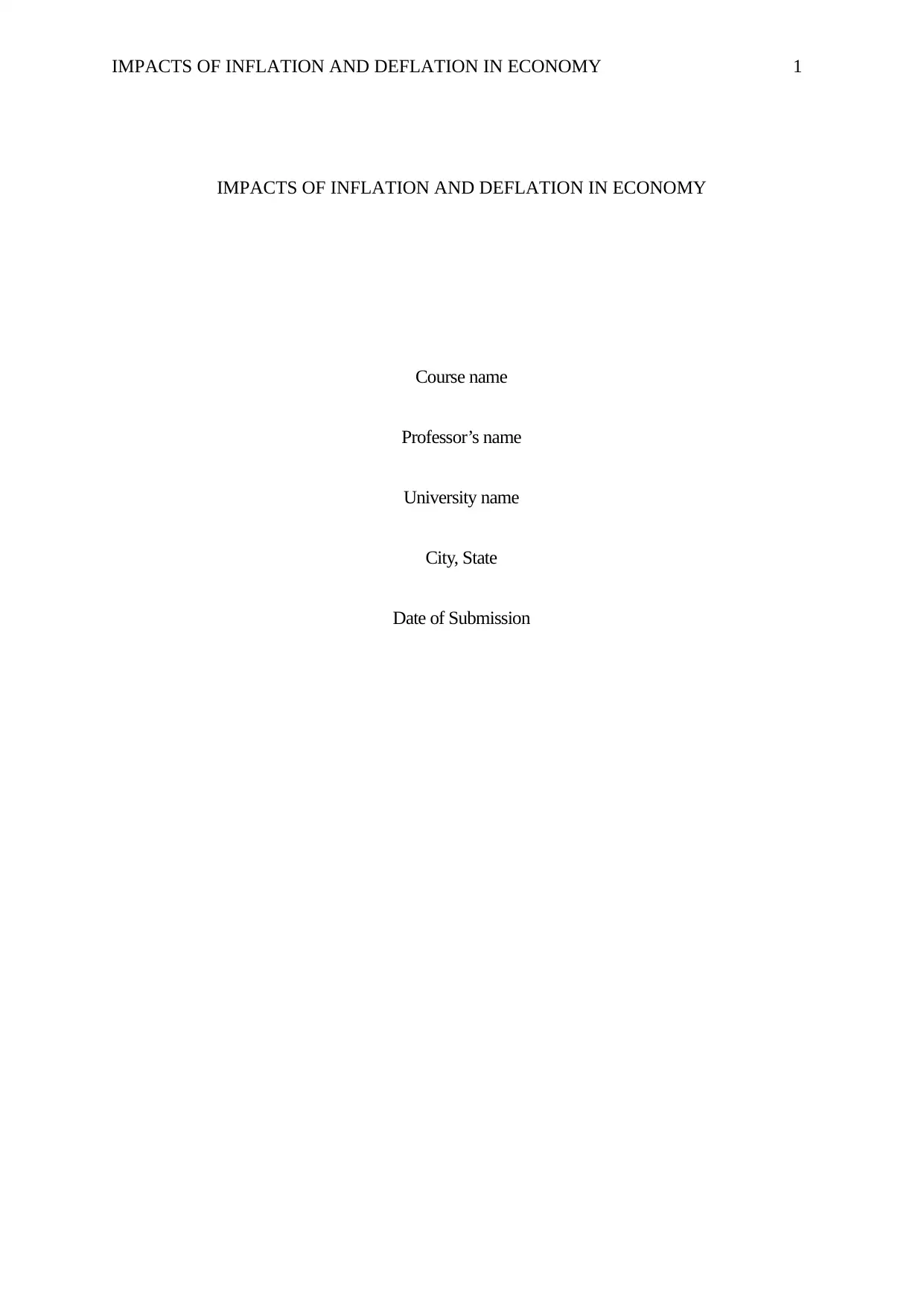
IMPACTS OF INFLATION AND DEFLATION IN ECONOMY 1
IMPACTS OF INFLATION AND DEFLATION IN ECONOMY
Course name
Professor’s name
University name
City, State
Date of Submission
IMPACTS OF INFLATION AND DEFLATION IN ECONOMY
Course name
Professor’s name
University name
City, State
Date of Submission
Paraphrase This Document
Need a fresh take? Get an instant paraphrase of this document with our AI Paraphraser
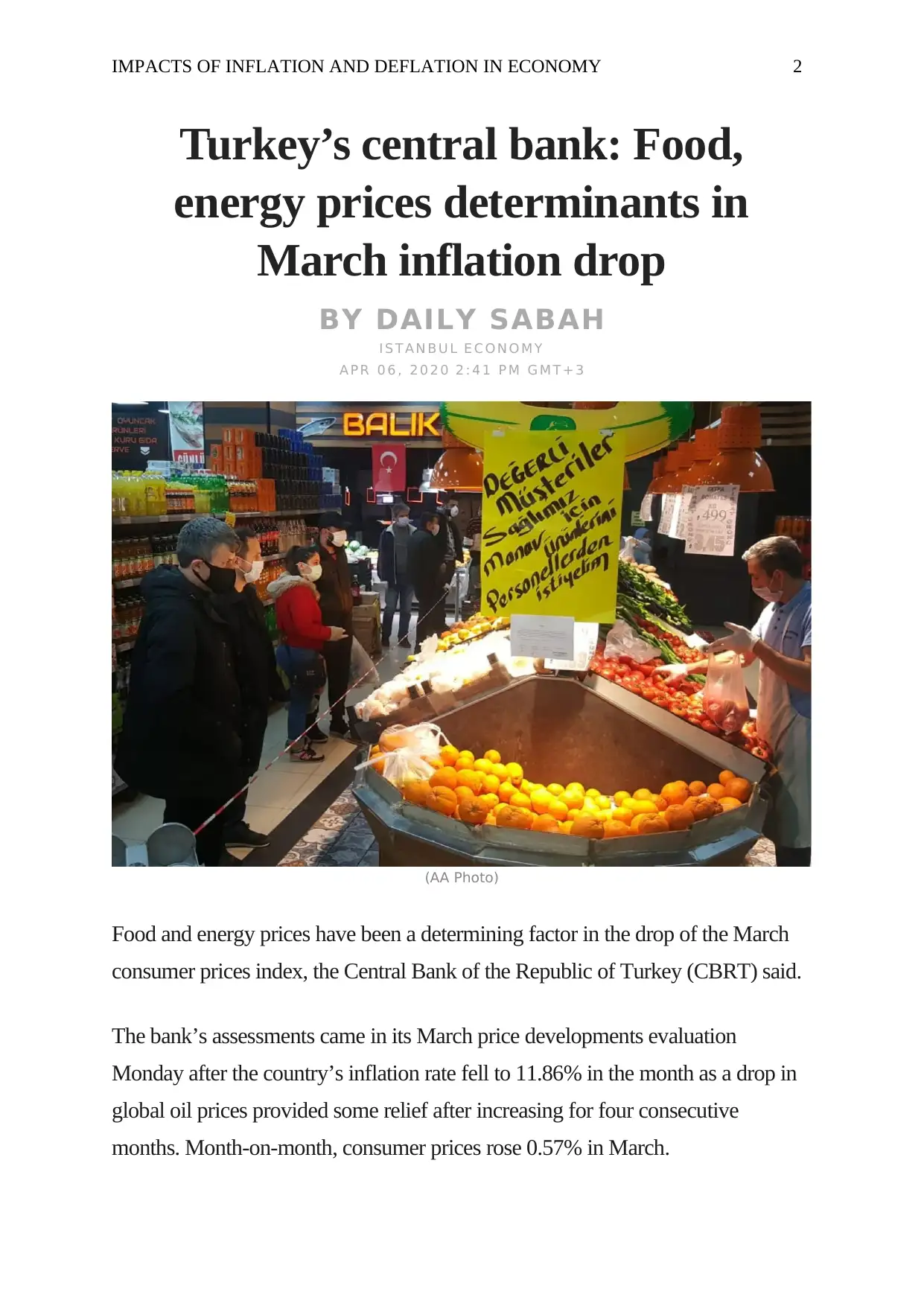
IMPACTS OF INFLATION AND DEFLATION IN ECONOMY 2
Turkey’s central bank: Food,
energy prices determinants in
March inflation drop
BY DAILY SABAH
I S T A N B U L E C O N O M Y
A P R 0 6 , 2 0 2 0 2 : 4 1 P M G M T + 3
(AA Photo)
Food and energy prices have been a determining factor in the drop of the March
consumer prices index, the Central Bank of the Republic of Turkey (CBRT) said.
The bank’s assessments came in its March price developments evaluation
Monday after the country’s inflation rate fell to 11.86% in the month as a drop in
global oil prices provided some relief after increasing for four consecutive
months. Month-on-month, consumer prices rose 0.57% in March.
Turkey’s central bank: Food,
energy prices determinants in
March inflation drop
BY DAILY SABAH
I S T A N B U L E C O N O M Y
A P R 0 6 , 2 0 2 0 2 : 4 1 P M G M T + 3
(AA Photo)
Food and energy prices have been a determining factor in the drop of the March
consumer prices index, the Central Bank of the Republic of Turkey (CBRT) said.
The bank’s assessments came in its March price developments evaluation
Monday after the country’s inflation rate fell to 11.86% in the month as a drop in
global oil prices provided some relief after increasing for four consecutive
months. Month-on-month, consumer prices rose 0.57% in March.
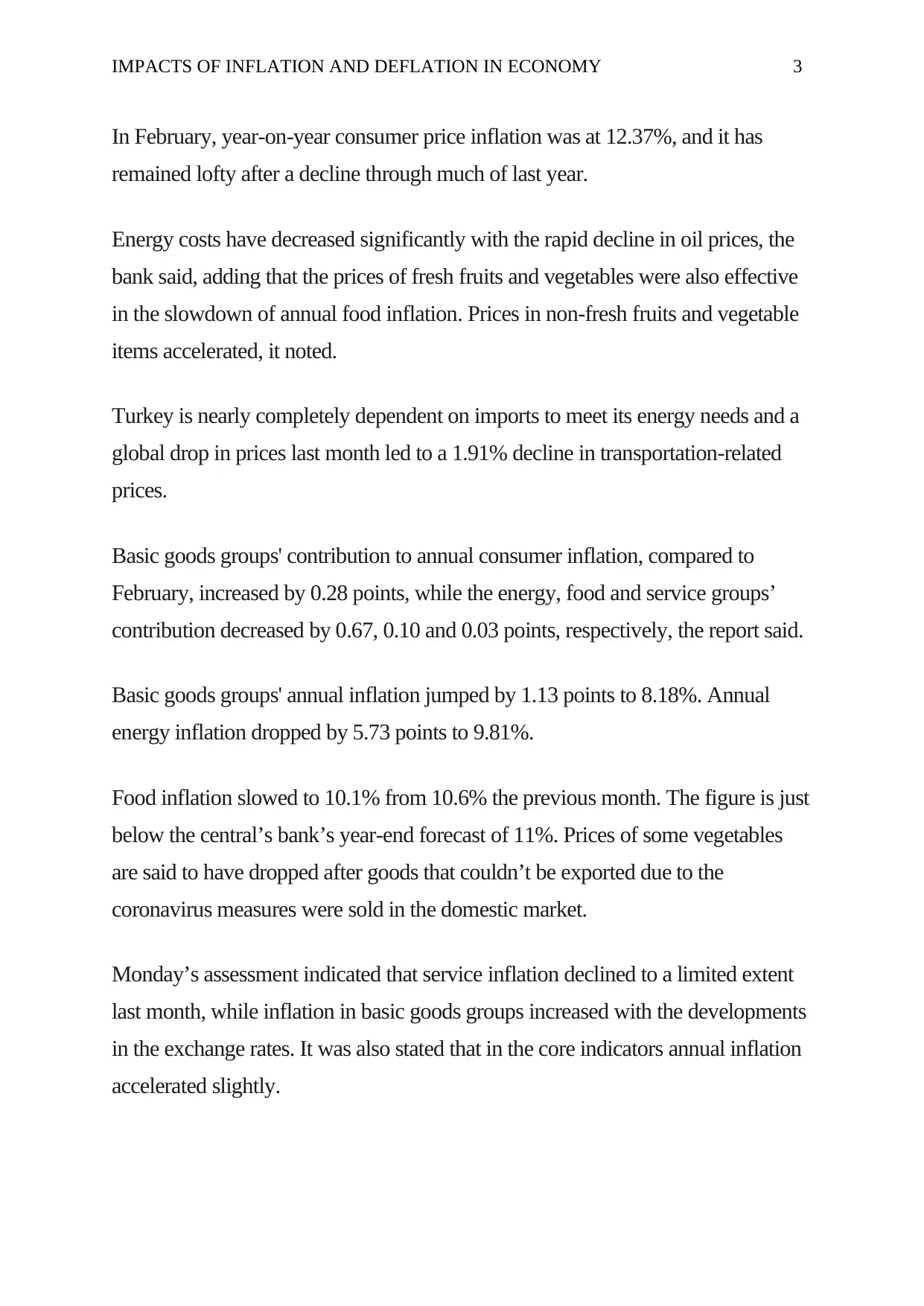
IMPACTS OF INFLATION AND DEFLATION IN ECONOMY 3
In February, year-on-year consumer price inflation was at 12.37%, and it has
remained lofty after a decline through much of last year.
Energy costs have decreased significantly with the rapid decline in oil prices, the
bank said, adding that the prices of fresh fruits and vegetables were also effective
in the slowdown of annual food inflation. Prices in non-fresh fruits and vegetable
items accelerated, it noted.
Turkey is nearly completely dependent on imports to meet its energy needs and a
global drop in prices last month led to a 1.91% decline in transportation-related
prices.
Basic goods groups' contribution to annual consumer inflation, compared to
February, increased by 0.28 points, while the energy, food and service groups’
contribution decreased by 0.67, 0.10 and 0.03 points, respectively, the report said.
Basic goods groups' annual inflation jumped by 1.13 points to 8.18%. Annual
energy inflation dropped by 5.73 points to 9.81%.
Food inflation slowed to 10.1% from 10.6% the previous month. The figure is just
below the central’s bank’s year-end forecast of 11%. Prices of some vegetables
are said to have dropped after goods that couldn’t be exported due to the
coronavirus measures were sold in the domestic market.
Monday’s assessment indicated that service inflation declined to a limited extent
last month, while inflation in basic goods groups increased with the developments
in the exchange rates. It was also stated that in the core indicators annual inflation
accelerated slightly.
In February, year-on-year consumer price inflation was at 12.37%, and it has
remained lofty after a decline through much of last year.
Energy costs have decreased significantly with the rapid decline in oil prices, the
bank said, adding that the prices of fresh fruits and vegetables were also effective
in the slowdown of annual food inflation. Prices in non-fresh fruits and vegetable
items accelerated, it noted.
Turkey is nearly completely dependent on imports to meet its energy needs and a
global drop in prices last month led to a 1.91% decline in transportation-related
prices.
Basic goods groups' contribution to annual consumer inflation, compared to
February, increased by 0.28 points, while the energy, food and service groups’
contribution decreased by 0.67, 0.10 and 0.03 points, respectively, the report said.
Basic goods groups' annual inflation jumped by 1.13 points to 8.18%. Annual
energy inflation dropped by 5.73 points to 9.81%.
Food inflation slowed to 10.1% from 10.6% the previous month. The figure is just
below the central’s bank’s year-end forecast of 11%. Prices of some vegetables
are said to have dropped after goods that couldn’t be exported due to the
coronavirus measures were sold in the domestic market.
Monday’s assessment indicated that service inflation declined to a limited extent
last month, while inflation in basic goods groups increased with the developments
in the exchange rates. It was also stated that in the core indicators annual inflation
accelerated slightly.
⊘ This is a preview!⊘
Do you want full access?
Subscribe today to unlock all pages.

Trusted by 1+ million students worldwide
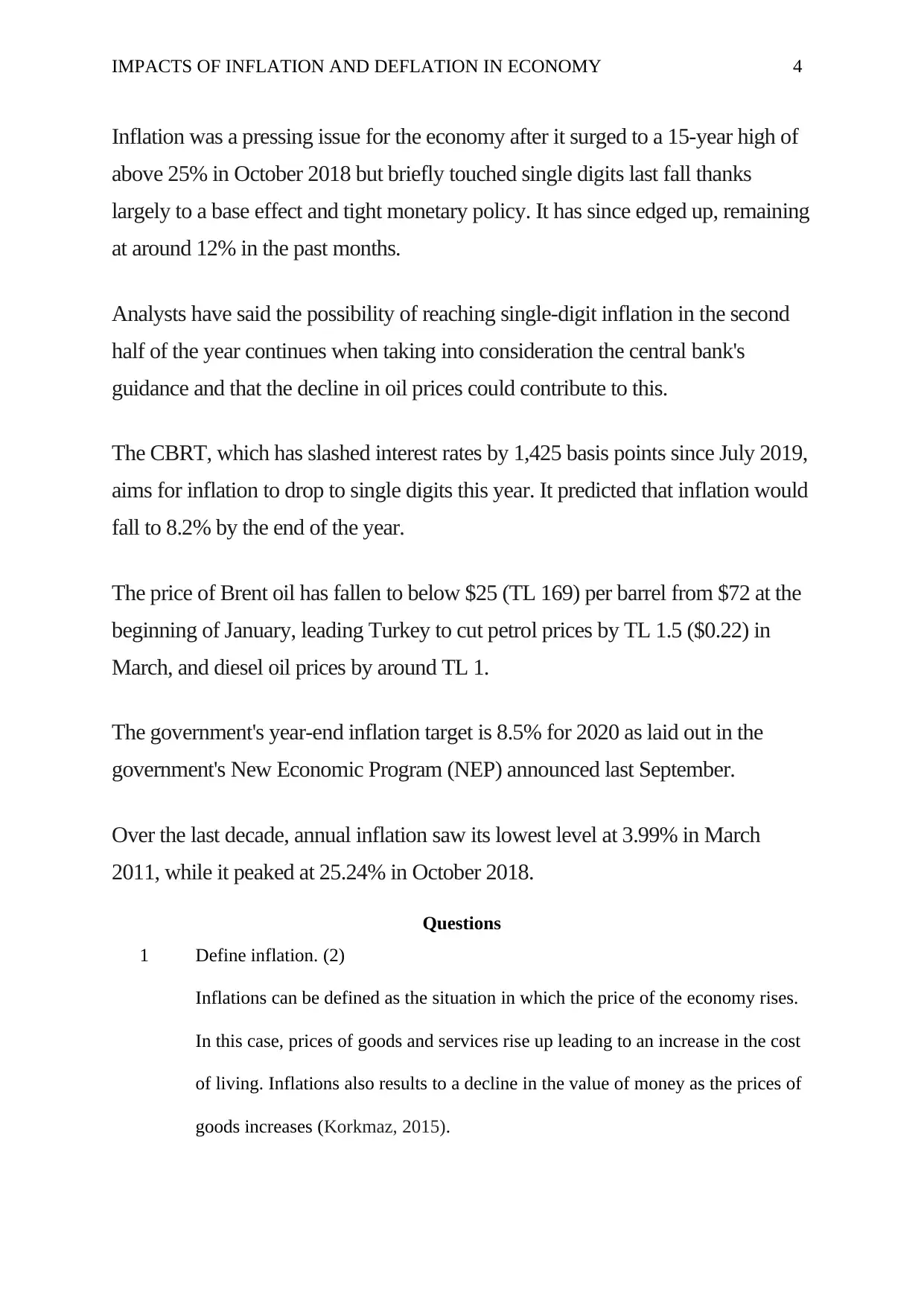
IMPACTS OF INFLATION AND DEFLATION IN ECONOMY 4
Inflation was a pressing issue for the economy after it surged to a 15-year high of
above 25% in October 2018 but briefly touched single digits last fall thanks
largely to a base effect and tight monetary policy. It has since edged up, remaining
at around 12% in the past months.
Analysts have said the possibility of reaching single-digit inflation in the second
half of the year continues when taking into consideration the central bank's
guidance and that the decline in oil prices could contribute to this.
The CBRT, which has slashed interest rates by 1,425 basis points since July 2019,
aims for inflation to drop to single digits this year. It predicted that inflation would
fall to 8.2% by the end of the year.
The price of Brent oil has fallen to below $25 (TL 169) per barrel from $72 at the
beginning of January, leading Turkey to cut petrol prices by TL 1.5 ($0.22) in
March, and diesel oil prices by around TL 1.
The government's year-end inflation target is 8.5% for 2020 as laid out in the
government's New Economic Program (NEP) announced last September.
Over the last decade, annual inflation saw its lowest level at 3.99% in March
2011, while it peaked at 25.24% in October 2018.
Questions
1 Define inflation. (2)
Inflations can be defined as the situation in which the price of the economy rises.
In this case, prices of goods and services rise up leading to an increase in the cost
of living. Inflations also results to a decline in the value of money as the prices of
goods increases (Korkmaz, 2015).
Inflation was a pressing issue for the economy after it surged to a 15-year high of
above 25% in October 2018 but briefly touched single digits last fall thanks
largely to a base effect and tight monetary policy. It has since edged up, remaining
at around 12% in the past months.
Analysts have said the possibility of reaching single-digit inflation in the second
half of the year continues when taking into consideration the central bank's
guidance and that the decline in oil prices could contribute to this.
The CBRT, which has slashed interest rates by 1,425 basis points since July 2019,
aims for inflation to drop to single digits this year. It predicted that inflation would
fall to 8.2% by the end of the year.
The price of Brent oil has fallen to below $25 (TL 169) per barrel from $72 at the
beginning of January, leading Turkey to cut petrol prices by TL 1.5 ($0.22) in
March, and diesel oil prices by around TL 1.
The government's year-end inflation target is 8.5% for 2020 as laid out in the
government's New Economic Program (NEP) announced last September.
Over the last decade, annual inflation saw its lowest level at 3.99% in March
2011, while it peaked at 25.24% in October 2018.
Questions
1 Define inflation. (2)
Inflations can be defined as the situation in which the price of the economy rises.
In this case, prices of goods and services rise up leading to an increase in the cost
of living. Inflations also results to a decline in the value of money as the prices of
goods increases (Korkmaz, 2015).
Paraphrase This Document
Need a fresh take? Get an instant paraphrase of this document with our AI Paraphraser
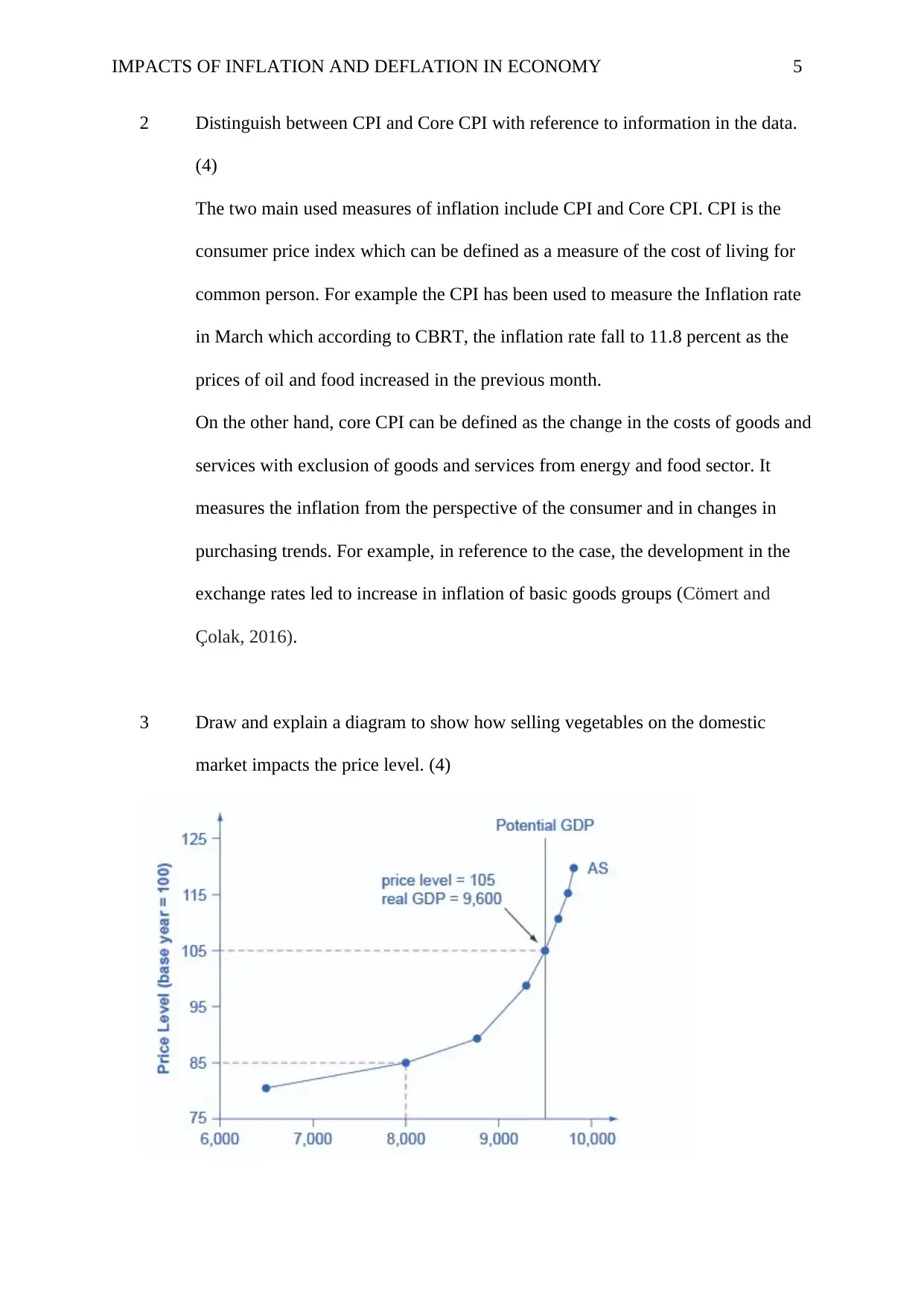
IMPACTS OF INFLATION AND DEFLATION IN ECONOMY 5
2 Distinguish between CPI and Core CPI with reference to information in the data.
(4)
The two main used measures of inflation include CPI and Core CPI. CPI is the
consumer price index which can be defined as a measure of the cost of living for
common person. For example the CPI has been used to measure the Inflation rate
in March which according to CBRT, the inflation rate fall to 11.8 percent as the
prices of oil and food increased in the previous month.
On the other hand, core CPI can be defined as the change in the costs of goods and
services with exclusion of goods and services from energy and food sector. It
measures the inflation from the perspective of the consumer and in changes in
purchasing trends. For example, in reference to the case, the development in the
exchange rates led to increase in inflation of basic goods groups (Cömert and
Çolak, 2016).
3 Draw and explain a diagram to show how selling vegetables on the domestic
market impacts the price level. (4)
2 Distinguish between CPI and Core CPI with reference to information in the data.
(4)
The two main used measures of inflation include CPI and Core CPI. CPI is the
consumer price index which can be defined as a measure of the cost of living for
common person. For example the CPI has been used to measure the Inflation rate
in March which according to CBRT, the inflation rate fall to 11.8 percent as the
prices of oil and food increased in the previous month.
On the other hand, core CPI can be defined as the change in the costs of goods and
services with exclusion of goods and services from energy and food sector. It
measures the inflation from the perspective of the consumer and in changes in
purchasing trends. For example, in reference to the case, the development in the
exchange rates led to increase in inflation of basic goods groups (Cömert and
Çolak, 2016).
3 Draw and explain a diagram to show how selling vegetables on the domestic
market impacts the price level. (4)
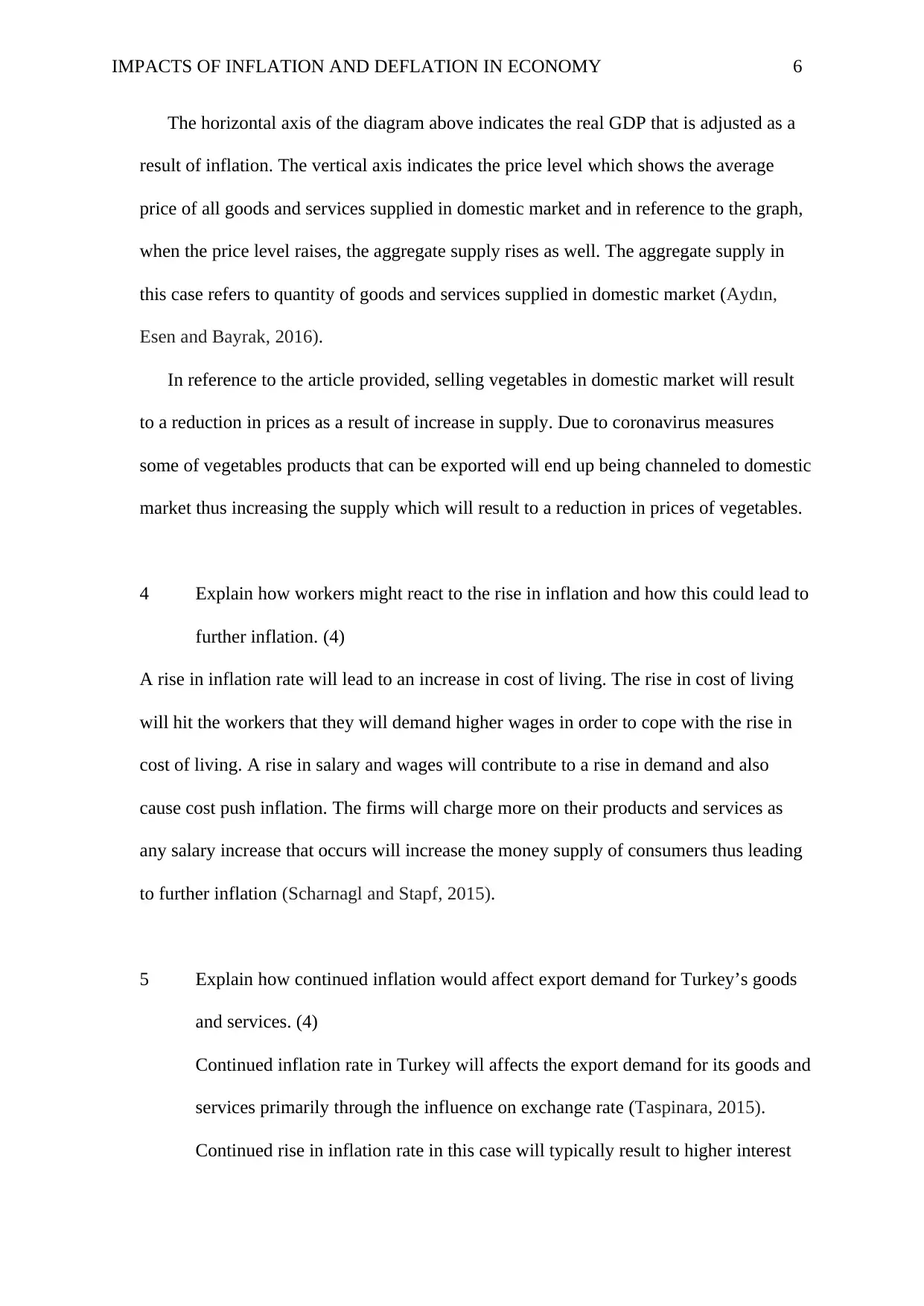
IMPACTS OF INFLATION AND DEFLATION IN ECONOMY 6
The horizontal axis of the diagram above indicates the real GDP that is adjusted as a
result of inflation. The vertical axis indicates the price level which shows the average
price of all goods and services supplied in domestic market and in reference to the graph,
when the price level raises, the aggregate supply rises as well. The aggregate supply in
this case refers to quantity of goods and services supplied in domestic market (Aydın,
Esen and Bayrak, 2016).
In reference to the article provided, selling vegetables in domestic market will result
to a reduction in prices as a result of increase in supply. Due to coronavirus measures
some of vegetables products that can be exported will end up being channeled to domestic
market thus increasing the supply which will result to a reduction in prices of vegetables.
4 Explain how workers might react to the rise in inflation and how this could lead to
further inflation. (4)
A rise in inflation rate will lead to an increase in cost of living. The rise in cost of living
will hit the workers that they will demand higher wages in order to cope with the rise in
cost of living. A rise in salary and wages will contribute to a rise in demand and also
cause cost push inflation. The firms will charge more on their products and services as
any salary increase that occurs will increase the money supply of consumers thus leading
to further inflation (Scharnagl and Stapf, 2015).
5 Explain how continued inflation would affect export demand for Turkey’s goods
and services. (4)
Continued inflation rate in Turkey will affects the export demand for its goods and
services primarily through the influence on exchange rate (Taspinara, 2015).
Continued rise in inflation rate in this case will typically result to higher interest
The horizontal axis of the diagram above indicates the real GDP that is adjusted as a
result of inflation. The vertical axis indicates the price level which shows the average
price of all goods and services supplied in domestic market and in reference to the graph,
when the price level raises, the aggregate supply rises as well. The aggregate supply in
this case refers to quantity of goods and services supplied in domestic market (Aydın,
Esen and Bayrak, 2016).
In reference to the article provided, selling vegetables in domestic market will result
to a reduction in prices as a result of increase in supply. Due to coronavirus measures
some of vegetables products that can be exported will end up being channeled to domestic
market thus increasing the supply which will result to a reduction in prices of vegetables.
4 Explain how workers might react to the rise in inflation and how this could lead to
further inflation. (4)
A rise in inflation rate will lead to an increase in cost of living. The rise in cost of living
will hit the workers that they will demand higher wages in order to cope with the rise in
cost of living. A rise in salary and wages will contribute to a rise in demand and also
cause cost push inflation. The firms will charge more on their products and services as
any salary increase that occurs will increase the money supply of consumers thus leading
to further inflation (Scharnagl and Stapf, 2015).
5 Explain how continued inflation would affect export demand for Turkey’s goods
and services. (4)
Continued inflation rate in Turkey will affects the export demand for its goods and
services primarily through the influence on exchange rate (Taspinara, 2015).
Continued rise in inflation rate in this case will typically result to higher interest
⊘ This is a preview!⊘
Do you want full access?
Subscribe today to unlock all pages.

Trusted by 1+ million students worldwide
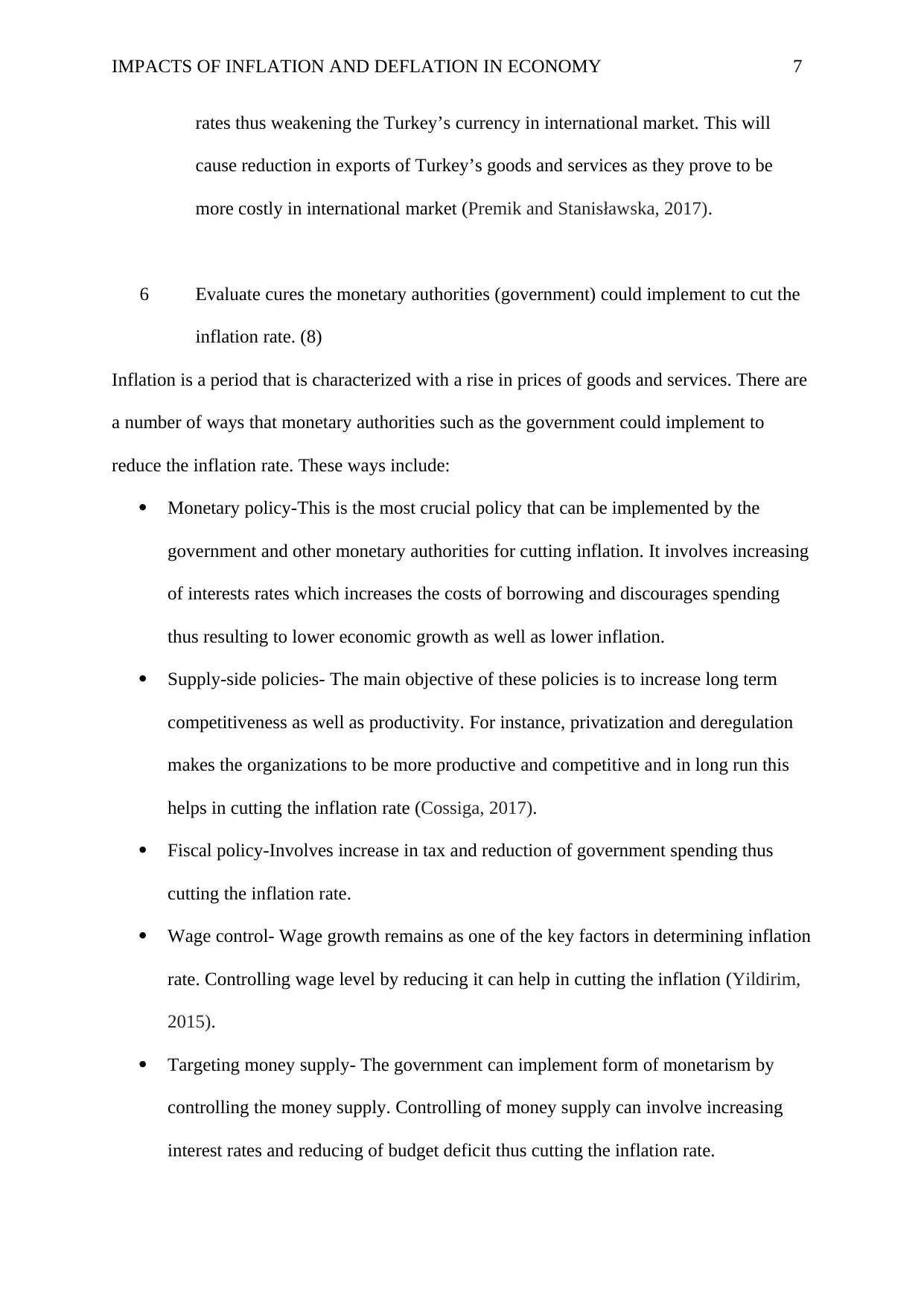
IMPACTS OF INFLATION AND DEFLATION IN ECONOMY 7
rates thus weakening the Turkey’s currency in international market. This will
cause reduction in exports of Turkey’s goods and services as they prove to be
more costly in international market (Premik and Stanisławska, 2017).
6 Evaluate cures the monetary authorities (government) could implement to cut the
inflation rate. (8)
Inflation is a period that is characterized with a rise in prices of goods and services. There are
a number of ways that monetary authorities such as the government could implement to
reduce the inflation rate. These ways include:
Monetary policy-This is the most crucial policy that can be implemented by the
government and other monetary authorities for cutting inflation. It involves increasing
of interests rates which increases the costs of borrowing and discourages spending
thus resulting to lower economic growth as well as lower inflation.
Supply-side policies- The main objective of these policies is to increase long term
competitiveness as well as productivity. For instance, privatization and deregulation
makes the organizations to be more productive and competitive and in long run this
helps in cutting the inflation rate (Cossiga, 2017).
Fiscal policy-Involves increase in tax and reduction of government spending thus
cutting the inflation rate.
Wage control- Wage growth remains as one of the key factors in determining inflation
rate. Controlling wage level by reducing it can help in cutting the inflation (Yildirim,
2015).
Targeting money supply- The government can implement form of monetarism by
controlling the money supply. Controlling of money supply can involve increasing
interest rates and reducing of budget deficit thus cutting the inflation rate.
rates thus weakening the Turkey’s currency in international market. This will
cause reduction in exports of Turkey’s goods and services as they prove to be
more costly in international market (Premik and Stanisławska, 2017).
6 Evaluate cures the monetary authorities (government) could implement to cut the
inflation rate. (8)
Inflation is a period that is characterized with a rise in prices of goods and services. There are
a number of ways that monetary authorities such as the government could implement to
reduce the inflation rate. These ways include:
Monetary policy-This is the most crucial policy that can be implemented by the
government and other monetary authorities for cutting inflation. It involves increasing
of interests rates which increases the costs of borrowing and discourages spending
thus resulting to lower economic growth as well as lower inflation.
Supply-side policies- The main objective of these policies is to increase long term
competitiveness as well as productivity. For instance, privatization and deregulation
makes the organizations to be more productive and competitive and in long run this
helps in cutting the inflation rate (Cossiga, 2017).
Fiscal policy-Involves increase in tax and reduction of government spending thus
cutting the inflation rate.
Wage control- Wage growth remains as one of the key factors in determining inflation
rate. Controlling wage level by reducing it can help in cutting the inflation (Yildirim,
2015).
Targeting money supply- The government can implement form of monetarism by
controlling the money supply. Controlling of money supply can involve increasing
interest rates and reducing of budget deficit thus cutting the inflation rate.
Paraphrase This Document
Need a fresh take? Get an instant paraphrase of this document with our AI Paraphraser
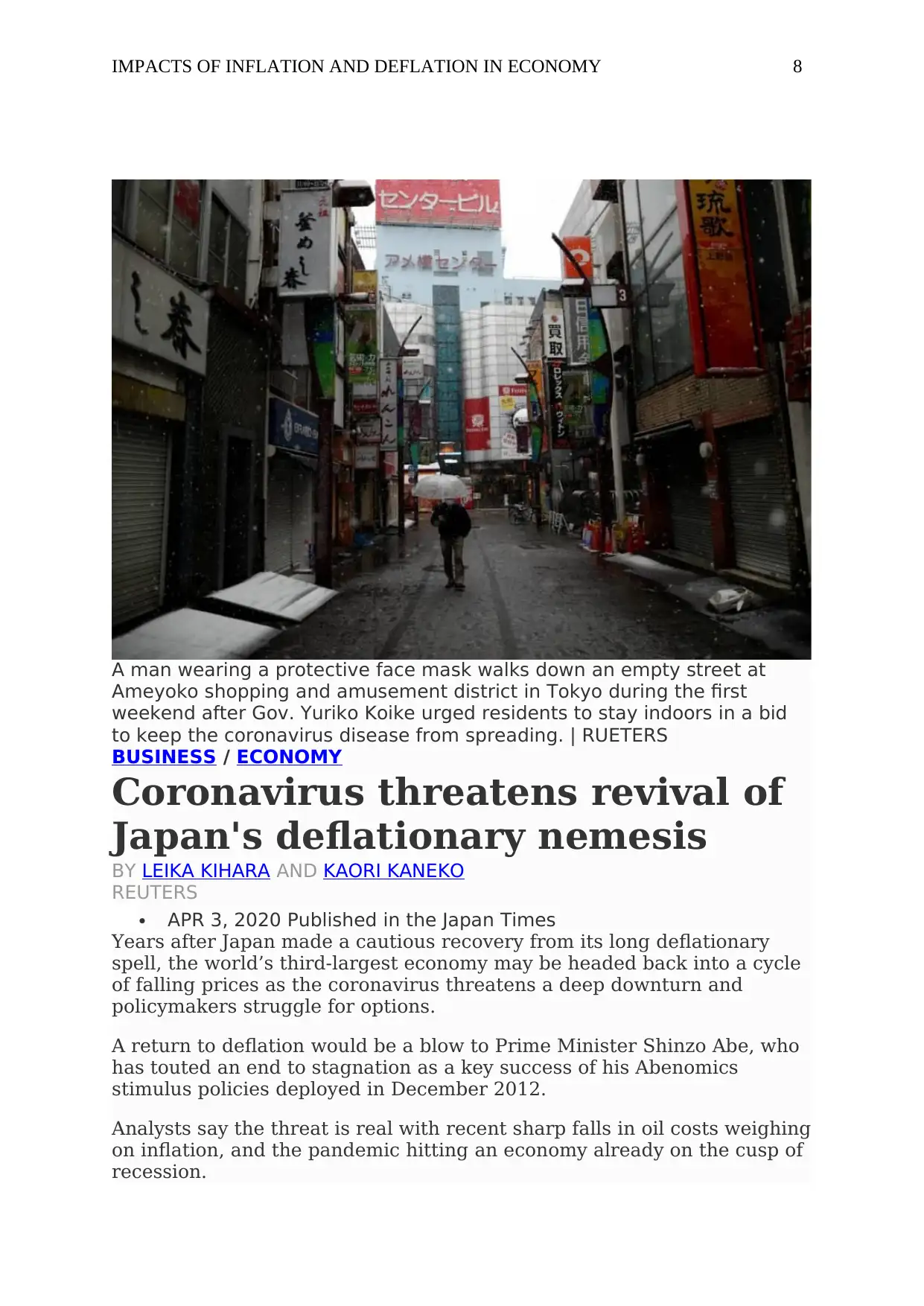
IMPACTS OF INFLATION AND DEFLATION IN ECONOMY 8
A man wearing a protective face mask walks down an empty street at
Ameyoko shopping and amusement district in Tokyo during the first
weekend after Gov. Yuriko Koike urged residents to stay indoors in a bid
to keep the coronavirus disease from spreading. | RUETERS
BUSINESS / ECONOMY
Coronavirus threatens revival of
Japan's deflationary nemesis
BY LEIKA KIHARA AND KAORI KANEKO
REUTERS
APR 3, 2020 Published in the Japan Times
Years after Japan made a cautious recovery from its long deflationary
spell, the world’s third-largest economy may be headed back into a cycle
of falling prices as the coronavirus threatens a deep downturn and
policymakers struggle for options.
A return to deflation would be a blow to Prime Minister Shinzo Abe, who
has touted an end to stagnation as a key success of his Abenomics
stimulus policies deployed in December 2012.
Analysts say the threat is real with recent sharp falls in oil costs weighing
on inflation, and the pandemic hitting an economy already on the cusp of
recession.
A man wearing a protective face mask walks down an empty street at
Ameyoko shopping and amusement district in Tokyo during the first
weekend after Gov. Yuriko Koike urged residents to stay indoors in a bid
to keep the coronavirus disease from spreading. | RUETERS
BUSINESS / ECONOMY
Coronavirus threatens revival of
Japan's deflationary nemesis
BY LEIKA KIHARA AND KAORI KANEKO
REUTERS
APR 3, 2020 Published in the Japan Times
Years after Japan made a cautious recovery from its long deflationary
spell, the world’s third-largest economy may be headed back into a cycle
of falling prices as the coronavirus threatens a deep downturn and
policymakers struggle for options.
A return to deflation would be a blow to Prime Minister Shinzo Abe, who
has touted an end to stagnation as a key success of his Abenomics
stimulus policies deployed in December 2012.
Analysts say the threat is real with recent sharp falls in oil costs weighing
on inflation, and the pandemic hitting an economy already on the cusp of
recession.
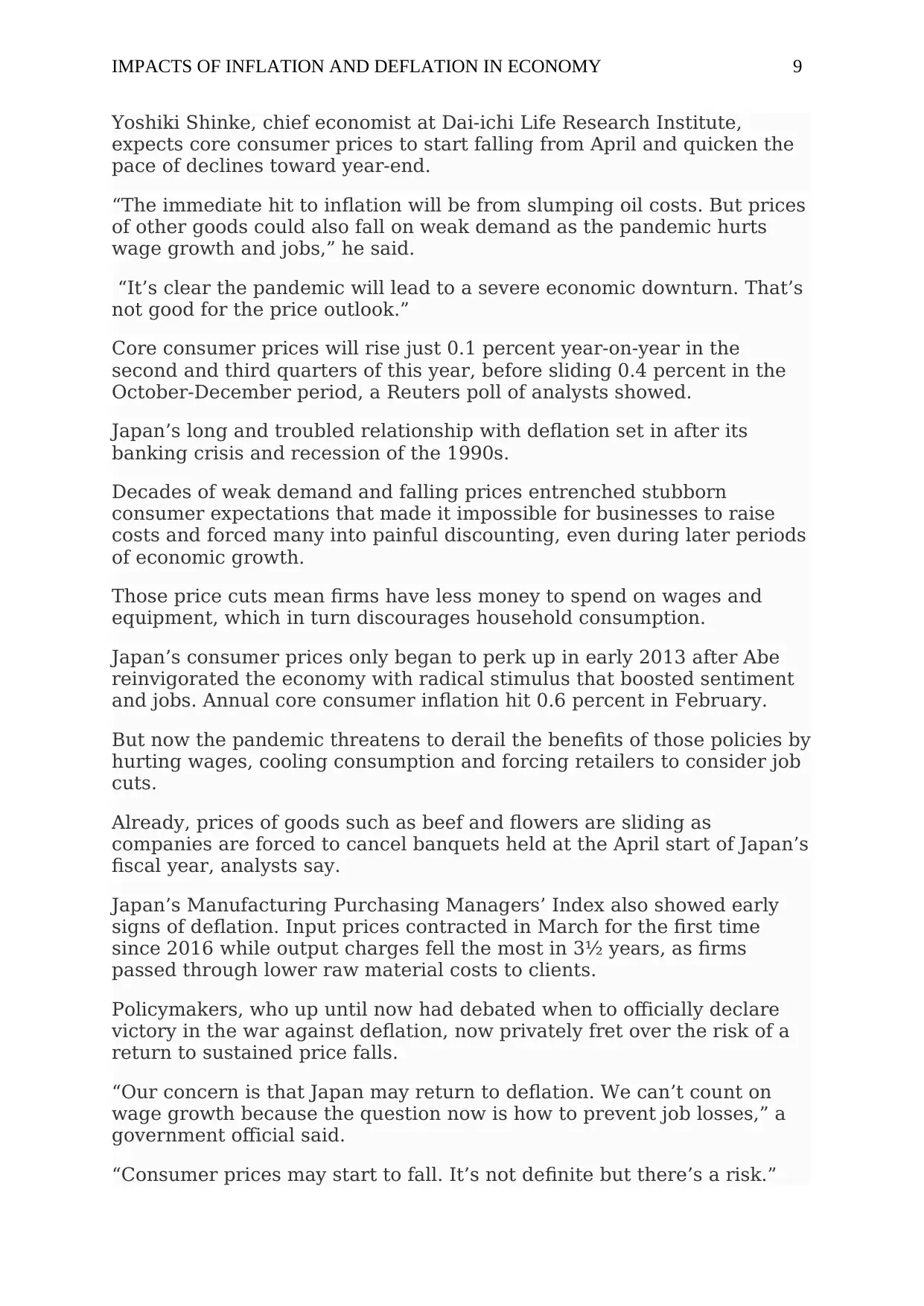
IMPACTS OF INFLATION AND DEFLATION IN ECONOMY 9
Yoshiki Shinke, chief economist at Dai-ichi Life Research Institute,
expects core consumer prices to start falling from April and quicken the
pace of declines toward year-end.
“The immediate hit to inflation will be from slumping oil costs. But prices
of other goods could also fall on weak demand as the pandemic hurts
wage growth and jobs,” he said.
“It’s clear the pandemic will lead to a severe economic downturn. That’s
not good for the price outlook.”
Core consumer prices will rise just 0.1 percent year-on-year in the
second and third quarters of this year, before sliding 0.4 percent in the
October-December period, a Reuters poll of analysts showed.
Japan’s long and troubled relationship with deflation set in after its
banking crisis and recession of the 1990s.
Decades of weak demand and falling prices entrenched stubborn
consumer expectations that made it impossible for businesses to raise
costs and forced many into painful discounting, even during later periods
of economic growth.
Those price cuts mean firms have less money to spend on wages and
equipment, which in turn discourages household consumption.
Japan’s consumer prices only began to perk up in early 2013 after Abe
reinvigorated the economy with radical stimulus that boosted sentiment
and jobs. Annual core consumer inflation hit 0.6 percent in February.
But now the pandemic threatens to derail the benefits of those policies by
hurting wages, cooling consumption and forcing retailers to consider job
cuts.
Already, prices of goods such as beef and flowers are sliding as
companies are forced to cancel banquets held at the April start of Japan’s
fiscal year, analysts say.
Japan’s Manufacturing Purchasing Managers’ Index also showed early
signs of deflation. Input prices contracted in March for the first time
since 2016 while output charges fell the most in 3½ years, as firms
passed through lower raw material costs to clients.
Policymakers, who up until now had debated when to officially declare
victory in the war against deflation, now privately fret over the risk of a
return to sustained price falls.
“Our concern is that Japan may return to deflation. We can’t count on
wage growth because the question now is how to prevent job losses,” a
government official said.
“Consumer prices may start to fall. It’s not definite but there’s a risk.”
Yoshiki Shinke, chief economist at Dai-ichi Life Research Institute,
expects core consumer prices to start falling from April and quicken the
pace of declines toward year-end.
“The immediate hit to inflation will be from slumping oil costs. But prices
of other goods could also fall on weak demand as the pandemic hurts
wage growth and jobs,” he said.
“It’s clear the pandemic will lead to a severe economic downturn. That’s
not good for the price outlook.”
Core consumer prices will rise just 0.1 percent year-on-year in the
second and third quarters of this year, before sliding 0.4 percent in the
October-December period, a Reuters poll of analysts showed.
Japan’s long and troubled relationship with deflation set in after its
banking crisis and recession of the 1990s.
Decades of weak demand and falling prices entrenched stubborn
consumer expectations that made it impossible for businesses to raise
costs and forced many into painful discounting, even during later periods
of economic growth.
Those price cuts mean firms have less money to spend on wages and
equipment, which in turn discourages household consumption.
Japan’s consumer prices only began to perk up in early 2013 after Abe
reinvigorated the economy with radical stimulus that boosted sentiment
and jobs. Annual core consumer inflation hit 0.6 percent in February.
But now the pandemic threatens to derail the benefits of those policies by
hurting wages, cooling consumption and forcing retailers to consider job
cuts.
Already, prices of goods such as beef and flowers are sliding as
companies are forced to cancel banquets held at the April start of Japan’s
fiscal year, analysts say.
Japan’s Manufacturing Purchasing Managers’ Index also showed early
signs of deflation. Input prices contracted in March for the first time
since 2016 while output charges fell the most in 3½ years, as firms
passed through lower raw material costs to clients.
Policymakers, who up until now had debated when to officially declare
victory in the war against deflation, now privately fret over the risk of a
return to sustained price falls.
“Our concern is that Japan may return to deflation. We can’t count on
wage growth because the question now is how to prevent job losses,” a
government official said.
“Consumer prices may start to fall. It’s not definite but there’s a risk.”
⊘ This is a preview!⊘
Do you want full access?
Subscribe today to unlock all pages.

Trusted by 1+ million students worldwide
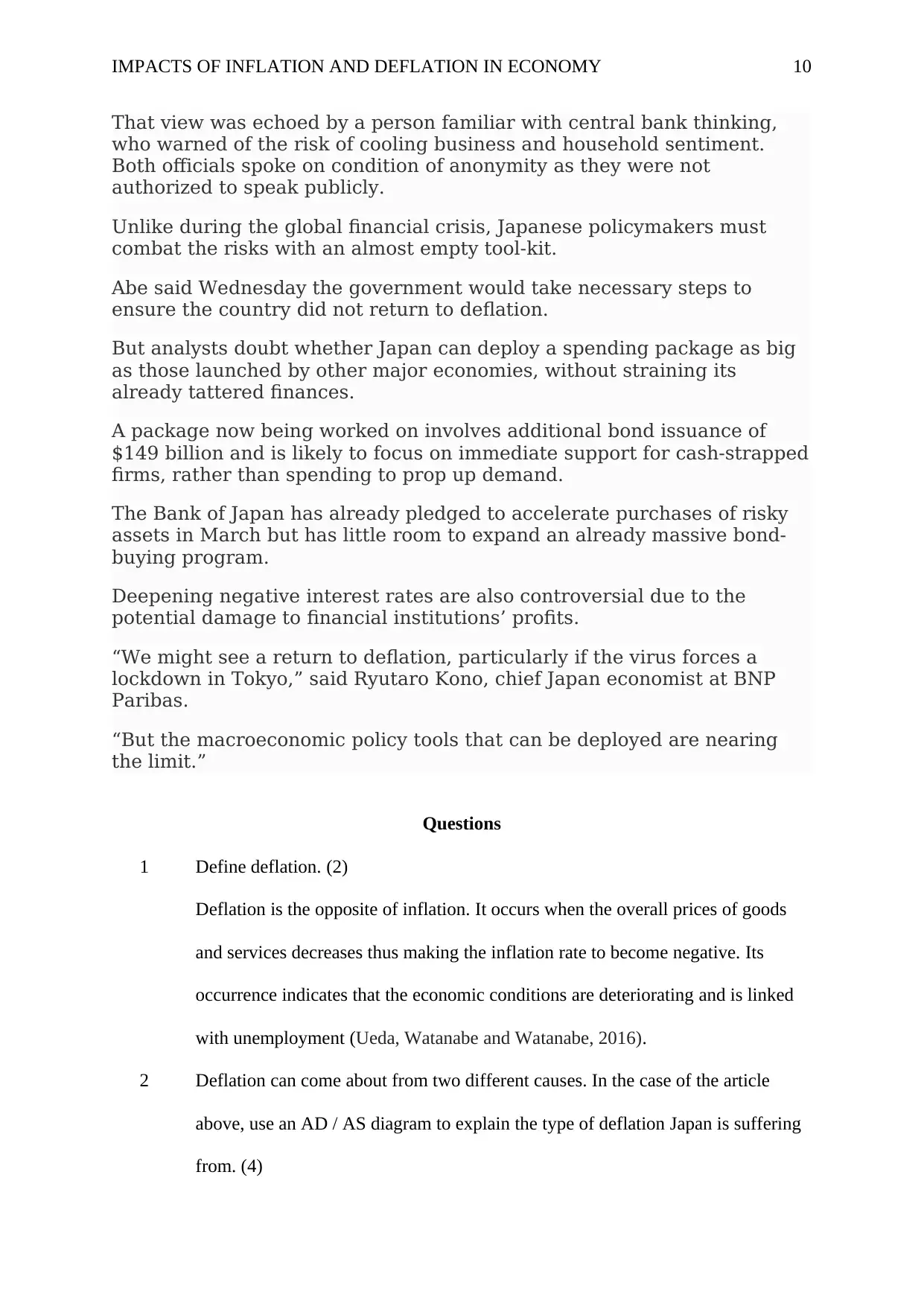
IMPACTS OF INFLATION AND DEFLATION IN ECONOMY 10
That view was echoed by a person familiar with central bank thinking,
who warned of the risk of cooling business and household sentiment.
Both officials spoke on condition of anonymity as they were not
authorized to speak publicly.
Unlike during the global financial crisis, Japanese policymakers must
combat the risks with an almost empty tool-kit.
Abe said Wednesday the government would take necessary steps to
ensure the country did not return to deflation.
But analysts doubt whether Japan can deploy a spending package as big
as those launched by other major economies, without straining its
already tattered finances.
A package now being worked on involves additional bond issuance of
$149 billion and is likely to focus on immediate support for cash-strapped
firms, rather than spending to prop up demand.
The Bank of Japan has already pledged to accelerate purchases of risky
assets in March but has little room to expand an already massive bond-
buying program.
Deepening negative interest rates are also controversial due to the
potential damage to financial institutions’ profits.
“We might see a return to deflation, particularly if the virus forces a
lockdown in Tokyo,” said Ryutaro Kono, chief Japan economist at BNP
Paribas.
“But the macroeconomic policy tools that can be deployed are nearing
the limit.”
Questions
1 Define deflation. (2)
Deflation is the opposite of inflation. It occurs when the overall prices of goods
and services decreases thus making the inflation rate to become negative. Its
occurrence indicates that the economic conditions are deteriorating and is linked
with unemployment (Ueda, Watanabe and Watanabe, 2016).
2 Deflation can come about from two different causes. In the case of the article
above, use an AD / AS diagram to explain the type of deflation Japan is suffering
from. (4)
That view was echoed by a person familiar with central bank thinking,
who warned of the risk of cooling business and household sentiment.
Both officials spoke on condition of anonymity as they were not
authorized to speak publicly.
Unlike during the global financial crisis, Japanese policymakers must
combat the risks with an almost empty tool-kit.
Abe said Wednesday the government would take necessary steps to
ensure the country did not return to deflation.
But analysts doubt whether Japan can deploy a spending package as big
as those launched by other major economies, without straining its
already tattered finances.
A package now being worked on involves additional bond issuance of
$149 billion and is likely to focus on immediate support for cash-strapped
firms, rather than spending to prop up demand.
The Bank of Japan has already pledged to accelerate purchases of risky
assets in March but has little room to expand an already massive bond-
buying program.
Deepening negative interest rates are also controversial due to the
potential damage to financial institutions’ profits.
“We might see a return to deflation, particularly if the virus forces a
lockdown in Tokyo,” said Ryutaro Kono, chief Japan economist at BNP
Paribas.
“But the macroeconomic policy tools that can be deployed are nearing
the limit.”
Questions
1 Define deflation. (2)
Deflation is the opposite of inflation. It occurs when the overall prices of goods
and services decreases thus making the inflation rate to become negative. Its
occurrence indicates that the economic conditions are deteriorating and is linked
with unemployment (Ueda, Watanabe and Watanabe, 2016).
2 Deflation can come about from two different causes. In the case of the article
above, use an AD / AS diagram to explain the type of deflation Japan is suffering
from. (4)
Paraphrase This Document
Need a fresh take? Get an instant paraphrase of this document with our AI Paraphraser
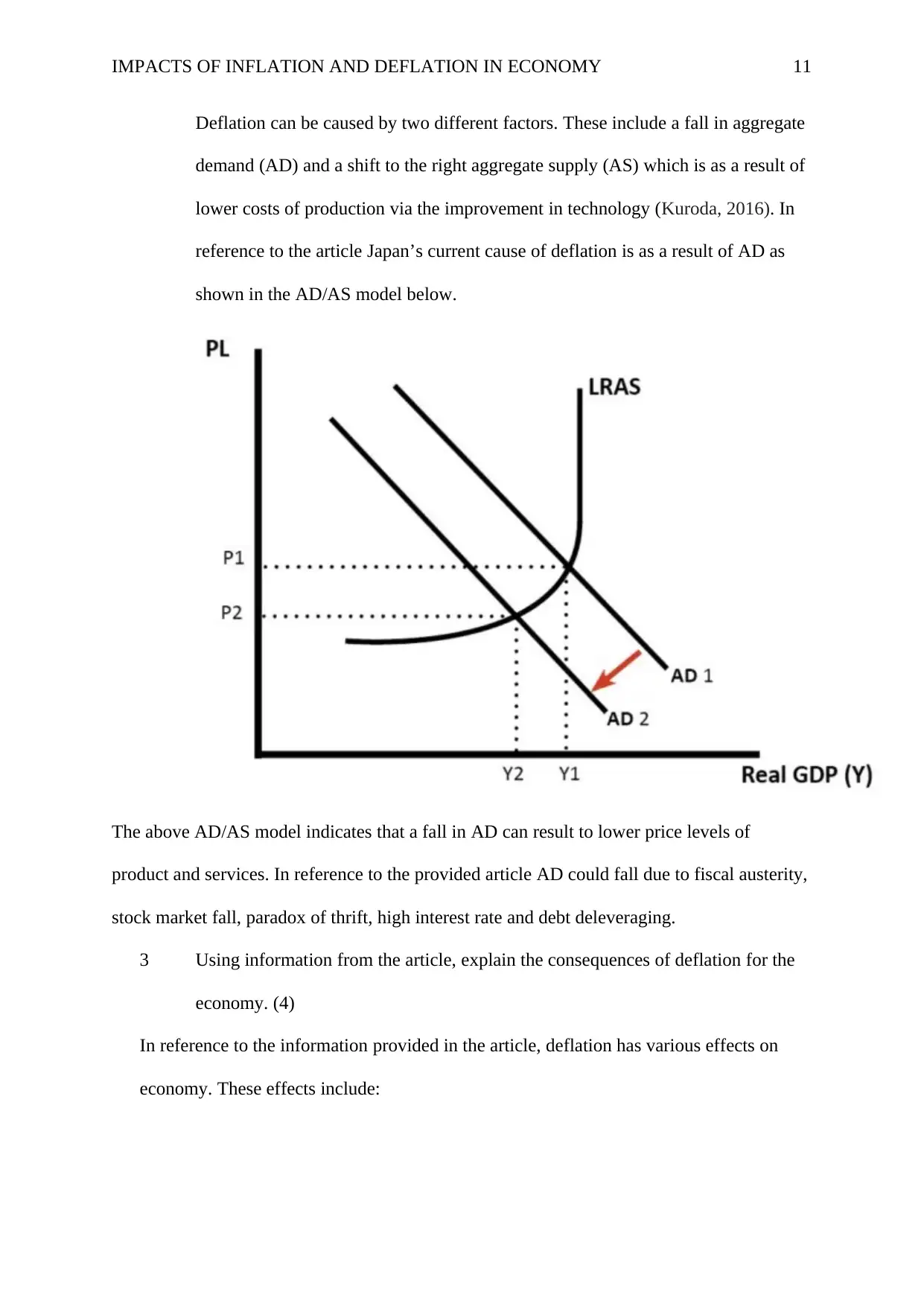
IMPACTS OF INFLATION AND DEFLATION IN ECONOMY 11
Deflation can be caused by two different factors. These include a fall in aggregate
demand (AD) and a shift to the right aggregate supply (AS) which is as a result of
lower costs of production via the improvement in technology (Kuroda, 2016). In
reference to the article Japan’s current cause of deflation is as a result of AD as
shown in the AD/AS model below.
The above AD/AS model indicates that a fall in AD can result to lower price levels of
product and services. In reference to the provided article AD could fall due to fiscal austerity,
stock market fall, paradox of thrift, high interest rate and debt deleveraging.
3 Using information from the article, explain the consequences of deflation for the
economy. (4)
In reference to the information provided in the article, deflation has various effects on
economy. These effects include:
Deflation can be caused by two different factors. These include a fall in aggregate
demand (AD) and a shift to the right aggregate supply (AS) which is as a result of
lower costs of production via the improvement in technology (Kuroda, 2016). In
reference to the article Japan’s current cause of deflation is as a result of AD as
shown in the AD/AS model below.
The above AD/AS model indicates that a fall in AD can result to lower price levels of
product and services. In reference to the provided article AD could fall due to fiscal austerity,
stock market fall, paradox of thrift, high interest rate and debt deleveraging.
3 Using information from the article, explain the consequences of deflation for the
economy. (4)
In reference to the information provided in the article, deflation has various effects on
economy. These effects include:
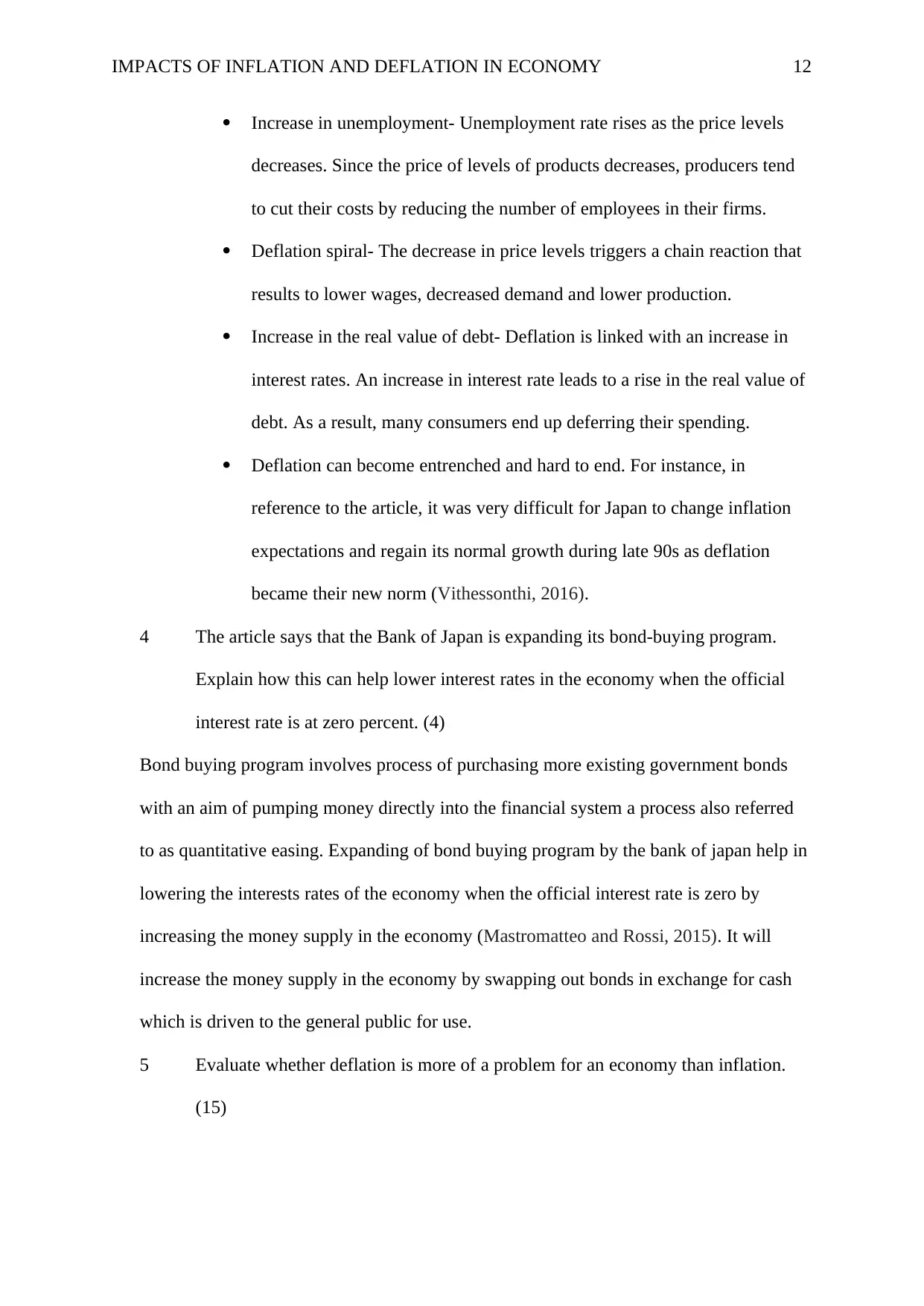
IMPACTS OF INFLATION AND DEFLATION IN ECONOMY 12
Increase in unemployment- Unemployment rate rises as the price levels
decreases. Since the price of levels of products decreases, producers tend
to cut their costs by reducing the number of employees in their firms.
Deflation spiral- The decrease in price levels triggers a chain reaction that
results to lower wages, decreased demand and lower production.
Increase in the real value of debt- Deflation is linked with an increase in
interest rates. An increase in interest rate leads to a rise in the real value of
debt. As a result, many consumers end up deferring their spending.
Deflation can become entrenched and hard to end. For instance, in
reference to the article, it was very difficult for Japan to change inflation
expectations and regain its normal growth during late 90s as deflation
became their new norm (Vithessonthi, 2016).
4 The article says that the Bank of Japan is expanding its bond-buying program.
Explain how this can help lower interest rates in the economy when the official
interest rate is at zero percent. (4)
Bond buying program involves process of purchasing more existing government bonds
with an aim of pumping money directly into the financial system a process also referred
to as quantitative easing. Expanding of bond buying program by the bank of japan help in
lowering the interests rates of the economy when the official interest rate is zero by
increasing the money supply in the economy (Mastromatteo and Rossi, 2015). It will
increase the money supply in the economy by swapping out bonds in exchange for cash
which is driven to the general public for use.
5 Evaluate whether deflation is more of a problem for an economy than inflation.
(15)
Increase in unemployment- Unemployment rate rises as the price levels
decreases. Since the price of levels of products decreases, producers tend
to cut their costs by reducing the number of employees in their firms.
Deflation spiral- The decrease in price levels triggers a chain reaction that
results to lower wages, decreased demand and lower production.
Increase in the real value of debt- Deflation is linked with an increase in
interest rates. An increase in interest rate leads to a rise in the real value of
debt. As a result, many consumers end up deferring their spending.
Deflation can become entrenched and hard to end. For instance, in
reference to the article, it was very difficult for Japan to change inflation
expectations and regain its normal growth during late 90s as deflation
became their new norm (Vithessonthi, 2016).
4 The article says that the Bank of Japan is expanding its bond-buying program.
Explain how this can help lower interest rates in the economy when the official
interest rate is at zero percent. (4)
Bond buying program involves process of purchasing more existing government bonds
with an aim of pumping money directly into the financial system a process also referred
to as quantitative easing. Expanding of bond buying program by the bank of japan help in
lowering the interests rates of the economy when the official interest rate is zero by
increasing the money supply in the economy (Mastromatteo and Rossi, 2015). It will
increase the money supply in the economy by swapping out bonds in exchange for cash
which is driven to the general public for use.
5 Evaluate whether deflation is more of a problem for an economy than inflation.
(15)
⊘ This is a preview!⊘
Do you want full access?
Subscribe today to unlock all pages.

Trusted by 1+ million students worldwide
1 out of 16
Your All-in-One AI-Powered Toolkit for Academic Success.
+13062052269
info@desklib.com
Available 24*7 on WhatsApp / Email
![[object Object]](/_next/static/media/star-bottom.7253800d.svg)
Unlock your academic potential
Copyright © 2020–2025 A2Z Services. All Rights Reserved. Developed and managed by ZUCOL.


